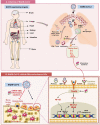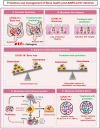Long-term implications of COVID-19 on bone health: pathophysiology and therapeutics
- PMID: 35900380
- PMCID: PMC9330992
- DOI: 10.1007/s00011-022-01616-9
Long-term implications of COVID-19 on bone health: pathophysiology and therapeutics
Abstract
Background: SARS-CoV-2 is a highly infectious respiratory virus associated with coronavirus disease (COVID-19). Discoveries in the field revealed that inflammatory conditions exert a negative impact on bone metabolism; however, only limited studies reported the consequences of SARS-CoV-2 infection on skeletal homeostasis. Inflammatory immune cells (T helper-Th17 cells and macrophages) and their signature cytokines such as interleukin (IL)-6, IL-17, and tumor necrosis factor-alpha (TNF-α) are the major contributors to the cytokine storm observed in COVID-19 disease. Our group along with others has proven that an enhanced population of both inflammatory innate (Dendritic cells-DCs, macrophages, etc.) and adaptive (Th1, Th17, etc.) immune cells, along with their signature cytokines (IL-17, TNF-α, IFN-γ, IL-6, etc.), are associated with various inflammatory bone loss conditions. Moreover, several pieces of evidence suggest that SARS-CoV-2 infects various organs of the body via angiotensin-converting enzyme 2 (ACE2) receptors including bone cells (osteoblasts-OBs and osteoclasts-OCs). This evidence thus clearly highlights both the direct and indirect impact of SARS-CoV-2 on the physiological bone remodeling process. Moreover, data from the previous SARS-CoV outbreak in 2002-2004 revealed the long-term negative impact (decreased bone mineral density-BMDs) of these infections on bone health.
Methodology: We used the keywords "immunopathogenesis of SARS-CoV-2," "SARS-CoV-2 and bone cells," "factors influencing bone health and COVID-19," "GUT microbiota," and "COVID-19 and Bone health" to integrate the topics for making this review article by searching the following electronic databases: PubMed, Google Scholar, and Scopus.
Conclusion: Current evidence and reports indicate the direct relation between SARS-CoV-2 infection and bone health and thus warrant future research in this field. It would be imperative to assess the post-COVID-19 fracture risk of SARS-CoV-2-infected individuals by simultaneously monitoring them for bone metabolism/biochemical markers. Importantly, several emerging research suggest that dysbiosis of the gut microbiota-GM (established role in inflammatory bone loss conditions) is further involved in the severity of COVID-19 disease. In the present review, we thus also highlight the importance of dietary interventions including probiotics (modulating dysbiotic GM) as an adjunct therapeutic alternative in the treatment and management of long-term consequences of COVID-19 on bone health.
Keywords: Bone health; COVID-19; Gut microbiota; Inflammation; Probiotics; SARS-CoV-2.
© 2022. The Author(s), under exclusive licence to Springer Nature Switzerland AG.
Conflict of interest statement
The authors report no conflicts of interest.
Figures







Similar articles
-
Adaptive immunity to SARS-CoV-2 infection: A systematic review.Front Immunol. 2022 Oct 10;13:1001198. doi: 10.3389/fimmu.2022.1001198. eCollection 2022. Front Immunol. 2022. PMID: 36300105 Free PMC article.
-
High levels of pro-inflammatory SARS-CoV-2-specific biomarkers revealed by in vitro whole blood cytokine release assay (CRA) in recovered and long-COVID-19 patients.PLoS One. 2023 Apr 5;18(4):e0283983. doi: 10.1371/journal.pone.0283983. eCollection 2023. PLoS One. 2023. PMID: 37018291 Free PMC article.
-
Proinflammatory Cytokine Profiles in Both Mild Symptomatic and Asymptomatic SARS-CoV-2-Infected Egyptian Individuals and a Proposed Relationship to Post-COVID-19 Sequela.Viral Immunol. 2023 Nov;36(9):600-609. doi: 10.1089/vim.2023.0060. Epub 2023 Oct 13. Viral Immunol. 2023. PMID: 37831918
-
SARS-CoV-2/ACE2 Interaction Suppresses IRAK-M Expression and Promotes Pro-Inflammatory Cytokine Production in Macrophages.Front Immunol. 2021 Jun 23;12:683800. doi: 10.3389/fimmu.2021.683800. eCollection 2021. Front Immunol. 2021. PMID: 34248968 Free PMC article.
-
COVID-19 and gut immunomodulation.World J Gastroenterol. 2021 Dec 14;27(46):7925-7942. doi: 10.3748/wjg.v27.i46.7925. World J Gastroenterol. 2021. PMID: 35046621 Free PMC article. Review.
Cited by
-
Unveiling the Oral Lesions, Dysgeusia and Osteonecrosis Related to COVID-19: A Comprehensive Systematic Review.J Clin Med. 2025 Feb 14;14(4):1267. doi: 10.3390/jcm14041267. J Clin Med. 2025. PMID: 40004799 Free PMC article. Review.
-
SARS-CoV-2 and its Multifaceted Impact on Bone Health: Mechanisms and Clinical Evidence.Curr Osteoporos Rep. 2024 Feb;22(1):135-145. doi: 10.1007/s11914-023-00843-1. Epub 2024 Jan 18. Curr Osteoporos Rep. 2024. PMID: 38236510 Free PMC article. Review.
-
Incidence and Outcomes of Vertebral Compression Fracture Among Patients Infected with COVID-19.J Clin Med. 2024 Dec 22;13(24):7830. doi: 10.3390/jcm13247830. J Clin Med. 2024. PMID: 39768754 Free PMC article.
-
Is there an Increase in Total Hip Arthroplasty Due to Osteonecrosis of Femoral Head After Covid-19 Pandemic?: A Retrospective Study Among Patients in Central Karnataka, India.J Orthop Case Rep. 2025 Jan;15(1):247-253. doi: 10.13107/jocr.2025.v15.i01.5190. J Orthop Case Rep. 2025. PMID: 39801841 Free PMC article.
-
Evaluation of Anti-SARS-CoV-2 IgG Responses in a Clinical Study of a Biosimilar Candidate to Denosumab Using Singlicate Analysis.Drugs R D. 2025 Jun;25(2):141-152. doi: 10.1007/s40268-025-00510-z. Epub 2025 May 23. Drugs R D. 2025. PMID: 40408051 Free PMC article.
References
Publication types
MeSH terms
Substances
Grants and funding
LinkOut - more resources
Full Text Sources
Medical
Miscellaneous

